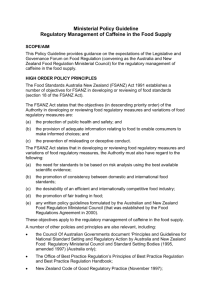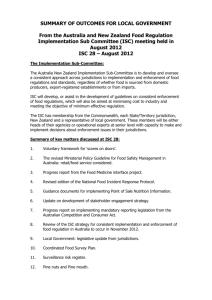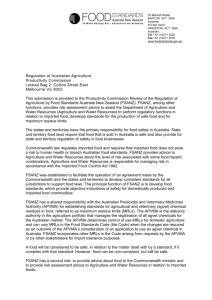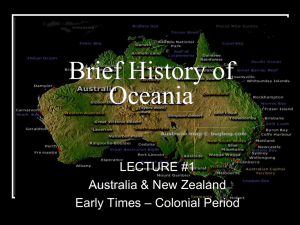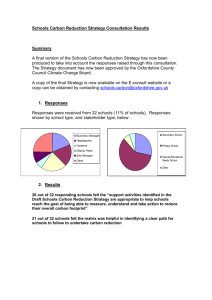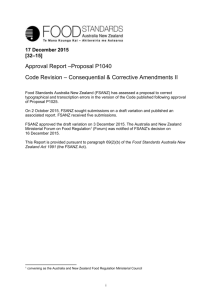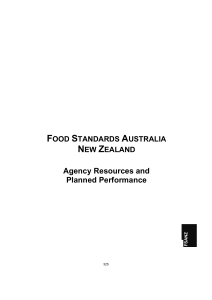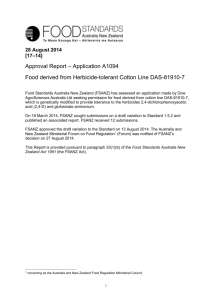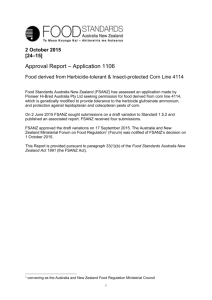Draft Stakeholder Engagement Strategy
advertisement
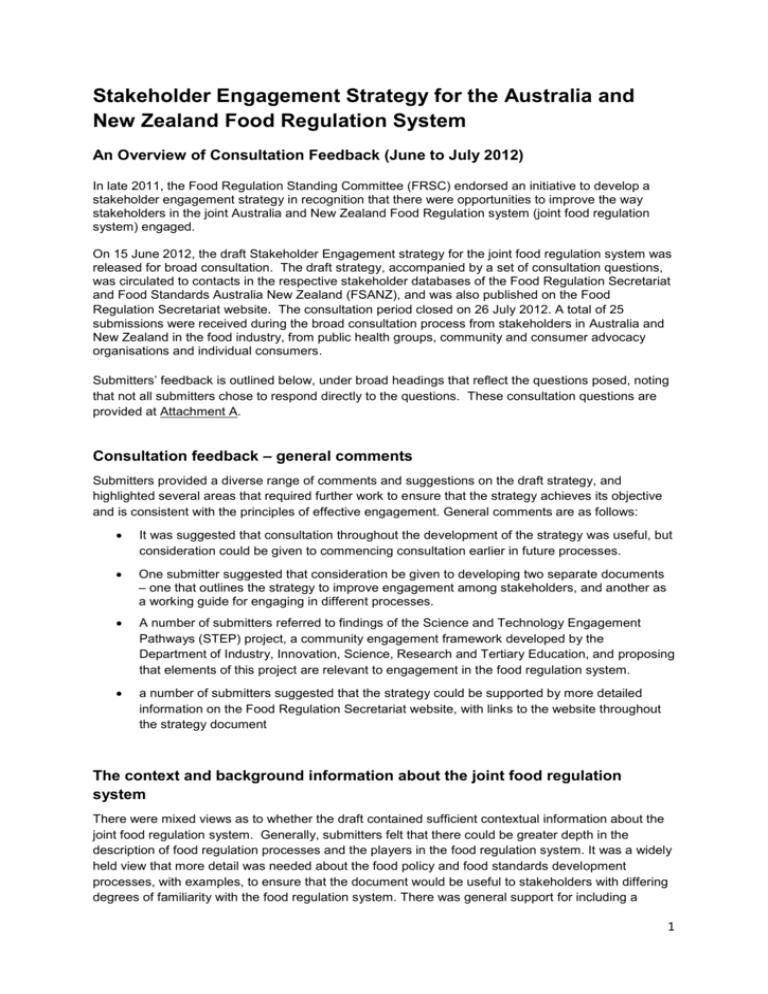
Stakeholder Engagement Strategy for the Australia and New Zealand Food Regulation System An Overview of Consultation Feedback (June to July 2012) In late 2011, the Food Regulation Standing Committee (FRSC) endorsed an initiative to develop a stakeholder engagement strategy in recognition that there were opportunities to improve the way stakeholders in the joint Australia and New Zealand Food Regulation system (joint food regulation system) engaged. On 15 June 2012, the draft Stakeholder Engagement strategy for the joint food regulation system was released for broad consultation. The draft strategy, accompanied by a set of consultation questions, was circulated to contacts in the respective stakeholder databases of the Food Regulation Secretariat and Food Standards Australia New Zealand (FSANZ), and was also published on the Food Regulation Secretariat website. The consultation period closed on 26 July 2012. A total of 25 submissions were received during the broad consultation process from stakeholders in Australia and New Zealand in the food industry, from public health groups, community and consumer advocacy organisations and individual consumers. Submitters’ feedback is outlined below, under broad headings that reflect the questions posed, noting that not all submitters chose to respond directly to the questions. These consultation questions are provided at Attachment A. Consultation feedback – general comments Submitters provided a diverse range of comments and suggestions on the draft strategy, and highlighted several areas that required further work to ensure that the strategy achieves its objective and is consistent with the principles of effective engagement. General comments are as follows: It was suggested that consultation throughout the development of the strategy was useful, but consideration could be given to commencing consultation earlier in future processes. One submitter suggested that consideration be given to developing two separate documents – one that outlines the strategy to improve engagement among stakeholders, and another as a working guide for engaging in different processes. A number of submitters referred to findings of the Science and Technology Engagement Pathways (STEP) project, a community engagement framework developed by the Department of Industry, Innovation, Science, Research and Tertiary Education, and proposing that elements of this project are relevant to engagement in the food regulation system. a number of submitters suggested that the strategy could be supported by more detailed information on the Food Regulation Secretariat website, with links to the website throughout the strategy document The context and background information about the joint food regulation system There were mixed views as to whether the draft contained sufficient contextual information about the joint food regulation system. Generally, submitters felt that there could be greater depth in the description of food regulation processes and the players in the food regulation system. It was a widely held view that more detail was needed about the food policy and food standards development processes, with examples, to ensure that the document would be useful to stakeholders with differing degrees of familiarity with the food regulation system. There was general support for including a 1 diagram to depict the key processes and responsibilities in the system. Submitters’ recommendations to improve the contextual information included: providing the background information about the food regulation system at the front-end of the strategy, to make this information clearer and more accessible, and providing more information about the rationale for the strategy itself in addition to other objectives, recognising that, under the Food Standards Australia New Zealand Act 1991 (FSANZ Act), there must also be regard for the desirability of an efficient and internationally competitive food industry and the promotion of fair trading describing the regulatory environment for sectors in the food production chain in a different way, by stating that all sectors operate within a framework of regulatory requirements, in addition to industry-initiated controls and systems to achieve best practice, such as industry standards or codes of practice clarifying how future stakeholder engagement processes might differ from current and past arrangements, providing examples of current problems and gaps and how the strategy might address these describing the relationships between the Legislative and Governance Forum on Food Regulation (Forum), Food Regulation Standing Committee (FRSC), Implementation Sub Committee (ISC), Food Regulation Secretariat and Food Standards Australia New Zealand (FSANZ), identifying the decision-makers, and providing balanced information about the roles and responsibilities in the food policy and food standard development processes, rather than over-emphasising implementation and enforcement responsibilities describing the continuum of food regulatory measures that could be applied to an issue (i.e. regulation, co-regulation and codes of practice), and managing the expectations of stakeholders in this regard, i.e. the strategy should not pre-empt that formal regulation will be the only outcome when stakeholders are seeking to resolve an issue referencing Council of Australian Governments’ (COAG) guidance about when formal regulation is an appropriate response to an issue, and presenting regulatory and nonregulatory processes as possible outcomes, rather than as distinctly different processes noting that considering formal regulation or other measures may begin with the same initial steps including background information about the rationale for separating the processes of policy development and standard development in the food regulation system, and describing the linkages between these processes and how food standards represent a particular policy direction. providing information about what occurs once a food policy or food standard is approved, i.e. the subsequent responsibility for monitoring, enforcement and any further action by industry/government/regulatory groups providing links to specific sources (e.g. website information) for further information about regulatory and non-regulatory processes, and information about meeting schedules and agendas for upcoming meetings of the Forum, FRSC, ISC. The scope and limitations of the joint food regulation system It was suggested that the strategy could provide a clearer description of the scope and limitations of the food regulation system, and some proposed that there be a dedicated page in the strategy that explicitly discusses this matter. 2 It was also suggested that some of the limitations of the system were not necessarily permanent and could be overcome by working collaboratively. Suggestions for how the strategy could enhance understanding of the scope and limitations and show how these are linked to stakeholder engagement included: clarifying whether one of the aims of the strategy is to have an impact on the scope and constraints of the System providing examples of issues and processes that are out-of-scope and the reason for this, and defining ‘food policy’ and ‘food standard’ to indicate the bounds of the system and help stakeholders determine the types of process they may wish to engage in included the membership of the Forum to clearly show its broad jurisdictional membership, and presenting an overview of the differences between Australia and New Zealand in adopting the Food Standards Code clarifying the range of regulatory and non-regulatory approaches available to address a food regulation issue, consistent with the direction given in the Overarching Strategic Statement for the Food Regulatory System, and the COAG requirement for Regulation Impact Assessment Understanding current processes and opportunities to effectively engage Several submitters responded that the strategy improved their understanding of the existing processes in the food regulation system and the opportunities to engage in the system and influence outcomes. One submitter gave support for the levels of engagement described in the strategy. A number of other submitters indicated that the information may be too simplistic for those stakeholders who are not already regularly engaged in the food regulation system, and provided the following suggestions to enhance the document to encourage understanding in these areas: including a greater detail about the relevant contacts in each jurisdiction and in other organisations, to demonstrate a genuine intent to facilitate engagement identifying the membership of the Forum, FRSC and ISC and their working groups, and providing information about who determines which policies should be developed and consulted on, and how this consultation will be carried out listing all stakeholders in the food regulation system (particularly the major consumer and public health organisations and peak industry bodies), and explaining the scope for other stakeholders to be involved in committees and working groups clarifying the role of FSANZ in the food policy development process, and explaining how it refers to a food policy when developing or varying a food standard, and what occurs when a policy is developed after a food standard is already in the Food Standards Code providing information about those who are typically involved in the food standards development process, other than FSANZ, and how stakeholders can effectively engage with FSANZ, and learn about activities being undertaken by FSANZ that are not part of its published workplan ensuring that the standards development process is described in the context of the whole food regulation system, such as clarifying the types of issues that FSANZ considered for standards development and the decisions that have already been made in the lead-up to a standards development or variation process. 3 indicating that, in addition to making an application to FSANZ for a new standard or variation to a standard, that stakeholders can seek the support of Forum members to raise a proposal for FSANZ to develop or vary a standard referring to the process of Regulation Impact Assessment under the direction of the COAG giving consideration to the confusion associated with multiple points of entry for stakeholders who are external to the food regulation system and wish to engage provide supporting text to clearly indicate the pathways in food policy and food standards development that stakeholders can access to engage in a process, and ensuring that the pathways shown in the strategy reflect the current reality for stakeholders across all sectors including a depiction of how stakeholders can engage in the process of standards implementation, and the mechanisms involved in implementation ensuring that the information about engagement pathways is explicit about the levels of engagement that can only be initiated by Government, and explaining how the framework of engagement levels will be used in practice for food policy and food standards development when stakeholders wish to engage in dialogue and influence decision-making clarify how consumers can influence processes at all levels of engagement, as the options currently presented appear limited and focussed on information-gathering rather than meaningful involvement providing information about the transparency and accountability of processes that include engagement with stakeholders, including whether processes will be accompanied by an engagement plan, whether outcomes of engagement will be reported to participants and other stakeholders, and an explanation of how input will be used to inform decisions referencing the ‘Coordination between the Department of Health and Ageing and Food Standards Australia New Zealand (FSANZ) for Health Incidents’ guidelines, which notes the key stakeholders and communication procedures for responding to emergency events. Roles and responsibilities of regulators, forums and groups Submitters asked that this section be strengthened by more clearly describing the different players in the food production chain, their responsibilities, their requirements, and relationships with one another. One submitter commented that it was unclear to many stakeholders why so many committees and groups were required for the System to function. Suggestions to enhance stakeholders’ understanding of roles and responsibilities included: clarifying that, while FSANZ develops food standards, the states and territories adopt the requirements of the Australia and New Zealand Food Standards Code through their Food Acts and are responsible for enforcing their Food Acts providing in-depth information about the obligations and internal workings of the various government committees and agencies at the Commonwealth, state and local government level, how their objectives are measured, and terms of reference for groups (where applicable) including a reference to the regulatory roles of the Australian Competition and Consumer Commission (ACCC) and the Australian Customs and Border Protection Service in relation to food 4 including a working example to demonstrate the roles and responsibilities in the food regulation system, and explaining the roles and responsibilities of stakeholders outside of government and across the entire food production chain clarifying the appropriate timing and stage (i.e. during policy development, standard development, or standard implementation) for an interested stakeholder to make contact with a member of the Forum, FRSC or ISC, or FSANZ to engage in a process offering a more structured approach to engaging in food policy development processes, particularly for organisations with overarching expertise, noting that the current approaches appear to be quite passive and do not encourage proactive contributions from stakeholders offering a mechanism to more actively communicate issues that are under consideration by government, avenues to contribute to these considerations from an early stage, upcoming key event, and changes to engagement processes providing a greater emphasis on two-way dialogue among stakeholders and a structured feedback-loop for those who are engaged in a process acknowledging the current inconsistencies and problems in the food regulation system that can hinder stakeholder engagement, and recognising stakeholders’ concerns about the transparency of food regulation decision-making processes The principles, vision and objective of the strategy Many submitters supported the draft principles for the strategy and found the vision and objective clear and meaningful. However, this view was not unanimous and some submitters offered alternative phrasing to improve clarity and meaning. Others noted that there may be different interpretations of how the principles should be applied in practice, and that it was unclear how the actions in the strategy would enact the principles and achieve the vision and objective. It was suggested that the principles, objective and vision may need to be reviewed over time as stakeholder engagement processes evolve. A comment was also made that the activities undertaken to implement the strategy will reveal whether the principles, vision and objectives are meaningful, and whether systemic problems with engagement can be resolved. The following proposals were made to amend the principles and how they are supported by the elements of the strategy: including a reference to commitment by the Forum, FRSC, ISC and FSANZ and government agencies to genuine engagement to ensure the best outcomes, and emphasising the need for all stakeholders to priorities engagement that facilitates understanding, develops the best possible policies and standards, and has regard to practical realities ensuring that the pathways for engagement outlined as part of the food policy and food standard development processes are consistent with the principles, particularly in regard to the principle regarding transparency refining the principle for ‘inclusion and balance’ to ensure that this applies to both Australia and New Zealand, being mindful of regulatory difference between the two countries ensuring that the strategy reflects the principle for 'outcome focussed' engagement by clearly articulating the constraints around confidentiality that are inherent in the decision-making processes of the Forum and its subordinate committees – stakeholder expectations could be managed in this regard by referring to confidential or 'closed' processes in the description of the food policy and food standards development processes 5 including a new principle about encouraging two-way dialogue between the Forum, FRSC, ISC, FSANZ and other stakeholders to identify solutions in a collaborative way ensuring that engagement opportunities are accurately represented to stakeholders, so that stakeholders understand what they can realistically influence with their time and resources, and within political and legal constraints including a principle about impacting on decision making, provide greater depth to principles, principles lack sufficient depth. In relation to the vision and objective, submitters suggested: defining ‘engagement’ for the purposes of the strategy, given that engagement could be interpreted as awareness-raising and providing information, and/or to two-way communication and input to decision making – it was suggested that the strategy should strive for more than awareness-raising, given that the current system has been in place for more than ten years a simpler and more succinct vision statement, which would be to ensure that the regulatory processes are transparent and credible, supported by a regulatory structure that is built on trust and integrity, which enables the development of an efficient and effective food regulatory system including a statement in the strategy about the need to achieve consistency in food regulation across Australia and New Zealand in order to achieve a truly joint system more clearly describing how the desired outcome of the strategy will be measured modifying the indicators of the strategy’s success to have stronger emphasis on communications, to ensure that stakeholders know where to access information throughout food policy and food standard development processes and about decisions that have been made. Intent to use the strategy and perceived usefulness Some submitters indicated that they would use the strategy, once finalised, as a reference guide in the future. Several submitters felt that the strategy was lacking a customer-service focus and were sceptical about whether this would be a helpful resource for stakeholders seeking engagement opportunities. It was suggested that the information does not enhance understanding among stakeholders who are experienced at engaging, and is not detailed enough to guide those who are new to the food regulation system. To make the strategy a more user-friendly resource to meet the needs of a wide range of stakeholders, submitters suggested: framing the strategy document as a starting point for stakeholders wishing to improve their understanding of how they can engage in processes clarifying the description of the intended audience for the strategy, by specifying the range of stakeholders, such as government, industry, public health and consumer groups and individual consumers with an interest in different food regulation issues ensuring that the document is presented in plain English, with limited technical and complex language using footnotes throughout the document to provide additional background information to assist those stakeholders who are new to the system ensure accessibility to engagement for people without computer access 6 including links to a schedule of meetings for the Forum, FRSC, ISC and the FSANZ Board, and related events simplifying the diagrams for the food policy and food standard development processes to more clearly identify the stages in each process when stakeholders can engage including actions to address issues that stakeholders have previously raised about engagement processes – issues such as stakeholders not understanding the consequences of changes to regulation, communicating with stakeholders on an ad-hoc basis, and perceptions of non-transparent decision making ensuring that the strategy can be utilised by government stakeholders, as well as stakeholders from industry, public health and consumer advocacy sectors and individual consumers providing details about how the strategy will be implemented, and the potential barriers to implementation committing to an evaluation of a real-life process, as a case study to determine the engagement activities that were effective and those that were not considering opportunities for consumer representation on committees and working groups within the food regulation system giving stakeholders a central portal of information, that be accessed as a single point of contact and transparent entry mechanism to engage expanding on the proposed initial activities to implement the strategy, acknowledging that some of these activities may ultimately require systemic changes to improve engagement emphasising the need for information exchanged between stakeholders during an engagement process to be based on evidence and objective risk assessment. Ease of understanding and navigating the draft strategy Some submitters stated that the strategy was a welcome addition to other information that is presently available about engaging in processes within the food regulation system, and that the document itself was easy to navigate as a high-level guide. However a number of stakeholders indicated that it was not easy to use the document and that it would not assist stakeholders who are unfamiliar with food regulation processes to navigate the complex food regulation system. It was proposed that the diagrams in the strategy require further refinement. Positive aspects of the draft strategy Generally submitters were supportive of the intent of the strategy and the need to enhance stakeholders’ understanding of, and access to, engagement opportunities in the food regulation system. Many submitters considered the use of diagrams throughout the document to be beneficial, and advised that the document is an appropriate length and is well-structured. There was support for the initial activities listed at the end of the strategy, particularly steps to improve the Food Regulation Secretariat website. One submitter expressed support for continued efforts to improve transparency in the rationale of food regulation decision making. A number of submitters were supportive of future evaluation of the strategy, but suggested that there should be more detail about how this will be carried out. 7 Attachment A Consultation Questions 1. Does the draft strategy provide enough context and background information about the joint food regulation system? 2. Does the draft strategy highlight the scope and limitations of the joint food regulation system? 3. Does the draft strategy give you an improved understanding of the current food regulation processes and opportunities for stakeholders to effectively engage and influence outcomes? 4. Does the draft strategy clarify the roles and responsibilities of regulators, forums and groups in the food regulation system? 5. Do you support the draft principles to underpin the strategy? Are the draft vision and objective of the strategy clear and meaningful to you as a stakeholder in the food regulation system? 6. If you wanted to engage in a particular food regulatory process, would you use this document to help you to determine how and when to do this? 7. How easy is it to understand and navigate the draft strategy? 8. What do you like about the draft strategy? What improvements should be made? 9. Other comments 8
